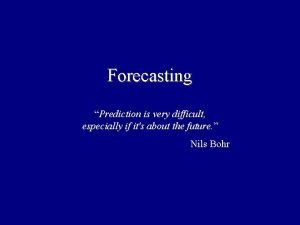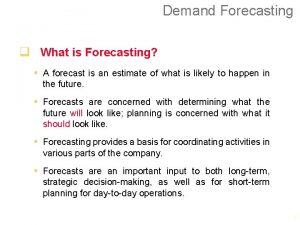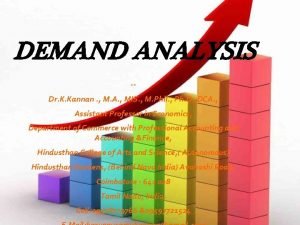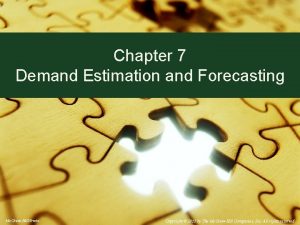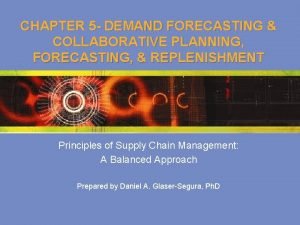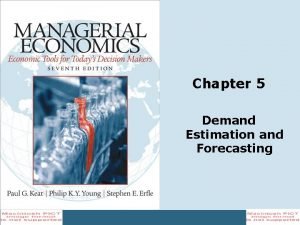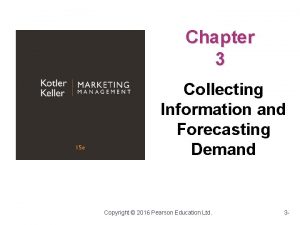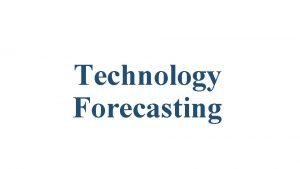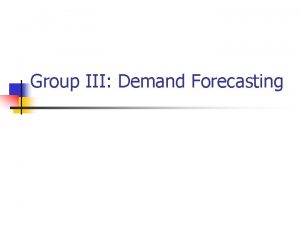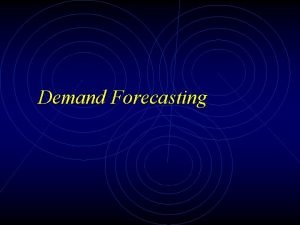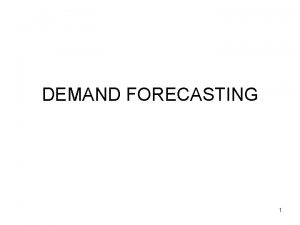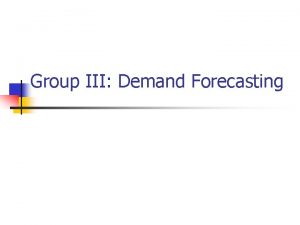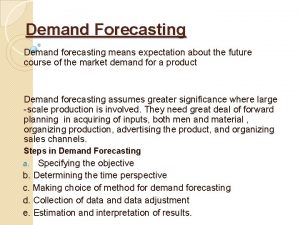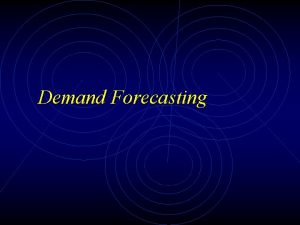Demand Forecasting Definition An estimate of future demand












- Slides: 12

Demand Forecasting.

. Definition. ․ ․ An estimate of future demand. A forecast can be determined by mathematical means using historical, it can be created subjectively by using estimates from informal sources, or it can represent a combination of both techniques. - 2 -

Need • To reduce uncertainty. • To anticipate inventory and capacity demands. • To project costs of operations. • To improve competitiveness • To improve productivity by decreasing costs • To improve delivery and • To be responsive to customer needs.

Methods of Forecasting Qualitative Techniques. • Based on expert or informed opinion • Information is intuitive and based on subjective judgment. • Techniques include collecting information from customer groups, experts, think tanks, research groups, etc.

Time Series Analysis • ․ It is based on the idea that data relating to past demand can be used to predict future demand. Past data may include trend, seasonal, or cyclical influences

Market Research • Market research is used mostly for looking new product ideas, like and dislikes about existing products, competitiveness of the existing products etc. Panel Consensus • Based on the idea that two heads are better than • A panel of people from a variety of positions develop forecast • Panel forecasts are developed through open meetings with free exchange of idea from all levels of management and individuals.

Delphi Method • The Delphi method hides the identity of the persons participating in the forecasting. Every person has the same weight. • A moderater produces a questionnaire and hand out it to participants. Their answers are summed up and given back to the whole group along with a new set of questions.

Quantitative Methods: Regression Analysis It is a method of fitting an equation to a data set. Simple regression involves one independent variable and one dependent variable. Least squares is the most common method of regression.

Quantitative Methods : Moving Average • An arithmetic average of of the most recent observations. • As each new observation is added, the old observation is discarded. • The value of n (the number of periods used to calculate average) reflects responsiveness versus firmness.

Moving Average Method

Weighted Moving Average • Simple moving average gives equal weight to each component, a weighted moving average allows any weights to be placed on each element, provided, the sum of all weights is equal to one

Exponential Smoothing. • A forecasting techniques in which past observations are geometrically discounted according to their age. The heaviest weight is assigned to the most recent data. • The techniques makes use of a smoothing constant to apply the difference between the most recent forecast and the critical sales data. F t = αA t– 1 + ( 1 - α) F where Ft A F = New forecast. t - 1 = Latest demand. = Previous forecast. α = Smoothing factor. (0 ≤ α ≤ 1) t- 1
 Demand estimation techniques
Demand estimation techniques Future perfect vs future perfect progressive
Future perfect vs future perfect progressive Future perfect simple continuous
Future perfect simple continuous Forecasting is difficult especially about the future
Forecasting is difficult especially about the future Hotel demand forecasting
Hotel demand forecasting Statistical methods of demand forecasting
Statistical methods of demand forecasting Chain ratio method examples
Chain ratio method examples Importance of forecasting
Importance of forecasting Statistical methods of demand forecasting
Statistical methods of demand forecasting Demand estimation and forecasting
Demand estimation and forecasting Collaborative planning and forecasting
Collaborative planning and forecasting Demand estimation and forecasting
Demand estimation and forecasting Forecasting and demand measurement in marketing
Forecasting and demand measurement in marketing



